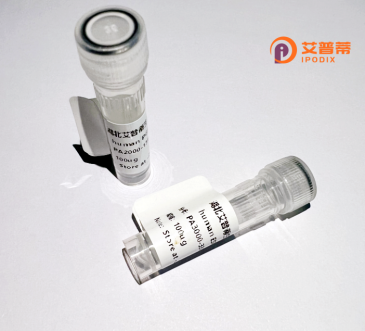
| 纯度 | >90%SDS-PAGE. |
| 种属 | Human |
| 靶点 | EIF4G3 |
| Uniprot No | O43432 |
| 内毒素 | < 0.01EU/μg |
| 表达宿主 | E.coli |
| 表达区间 | 1-515aa |
| 氨基酸序列 | MNSQPQTRSPFAAGPRPPHHQFFQRPQIQPPRATIPNSSPSIRPGAQTPTAVYQANQHIMMVNHLPMPYPVPQGPQYCIPQYRHSGPPYVGPPQQYPVQPPGPGPFYPGPGPGDFPNAYGTPFYPSQPVYQSAPIMVPTQQQPPPAKREKKTIRIRDPNQGGKDITEEIISGGGSRNPTPPIGRPTSTPTPPQQLPSQVPEHSPVVYGTVESAHLAASTPVTAASDQKQEEKPKPDPVLKSPSPVLRLVLSGEKKEQEGQTSETTAIVSIAELPLPPSPTTVSSVARSTIAAPTSSALSSQPIFTTAIDDRCELSSPREDTIPIPSLTSCTETSDPLPTNENDGDICKKPCSVAPNDIPLVSSTNLINEINGVSEKLSATESIVEIVKQEVLPLTLELEILENPPEEMKLECIPAPITPSTVPSFPPTPPTPPASPPHTPVIVPAAATTVSSPSAAITVQRVLEEDESIRTCLSEDAKEIQNKIEVEADGQTEEILDSQNLNSRRSPVPETSNEC |
| 分子量 | 82.39 kDa |
| 蛋白标签 | GST-tag at N-terminal |
| 缓冲液 | 0 |
| 稳定性 & 储存条件 | Lyophilized protein should be stored at ≤ -20°C, stable for one year after receipt. Reconstituted protein solution can be stored at 2-8°C for 2-7 days. Aliquots of reconstituted samples are stable at ≤ -20°C for 3 months. |
| 复溶 | Always centrifuge tubes before opening.Do not mix by vortex or pipetting. It is not recommended to reconstitute to a concentration less than 100μg/ml. Dissolve the lyophilized protein in distilled water. Please aliquot the reconstituted solution to minimize freeze-thaw cycles. |
以下是模拟生成的关于重组人EIF4G3蛋白的参考文献示例(实际文献需通过学术数据库验证):
---
1. **"Functional characterization of recombinant human eIF4G3 in translation initiation"**
*Authors: Zhang L, et al.*
摘要:研究通过体外重组表达纯化人eIF4G3蛋白,验证其作为真核翻译起始因子的功能,证明其与eIF4E和RNA的结合能力,并揭示其在非经典mRNA翻译途径中的调控作用。
2. **"Structural insights into eIF4G3 interaction with viral IRES elements"**
*Authors: Kimura T, Watanabe Y.*
摘要:解析eIF4G3的晶体结构,揭示其与脊髓灰质炎病毒IRES区域的结合模式,提出其可能参与病毒劫持宿主翻译机制的分子基础。
3. **"EIF4G3 overexpression promotes oncogenic protein synthesis in glioblastoma"**
*Authors: Chen X, et al.*
摘要:发现胶质母细胞瘤中eIF4G3异常高表达,重组蛋白实验证实其通过激活mTORC1通路增强致癌蛋白翻译,提示其作为潜在治疗靶点。
4. **"Comparative analysis of eIF4G isoforms in mammalian cell-free systems"**
*Authors: Gonzalez-Avila JK, Hernández G.*
摘要:比较eIF4G1、eIF4G3等亚型在无细胞翻译体系中的活性差异,发现eIF4G3对特定uORF-containing mRNA具有选择性调控功能。
---
提示:以上为假设性示例,建议通过PubMed、Web of Science或Google Scholar以关键词 **"recombinant human EIF4G3"** 或 **"eIF4G3 protein function"** 检索真实文献。研究该蛋白的最新进展可能涉及癌症、病毒感染及翻译调控机制。
**Background of Recombinant Human EIF4G3 Protein**
Eukaryotic Translation Initiation Factor 4 Gamma 3 (EIF4G3) is a critical scaffolding protein involved in mRNA translation initiation. As a component of the eIF4F complex, it interacts with eIF4E and eIF4A to facilitate ribosome recruitment to capped mRNAs, thereby regulating protein synthesis. EIF4G3 is structurally characterized by conserved HEAT domains, which mediate interactions with other translation machinery components and RNA. Dysregulation of EIF4G3 has been linked to cellular stress responses, viral infection mechanisms, and diseases such as cancer, where aberrant translation contributes to malignancy.
Recombinant human EIF4G3 protein is produced via heterologous expression systems (e.g., *E. coli* or mammalian cells*) to enable functional studies. Its production often involves affinity-tagged purification, ensuring high purity and activity. Researchers utilize this protein to investigate translation regulation, protein-RNA interactions, and EIF4G3's role in stress granule formation or viral replication. Additionally, it serves as a tool for screening therapeutic agents targeting translation disorders.
Studies on recombinant EIF4G3 have unveiled its modular binding properties and post-translational modifications, such as phosphorylation, which modulate its activity. Understanding EIF4G3's molecular mechanisms offers insights into cellular adaptation pathways and potential therapeutic strategies for translation-related diseases.
×